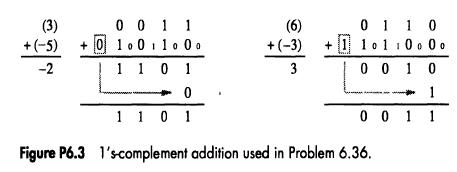The mantissa adder-subtractor in Figure 6.26 operates on positive, unsigned binary fractions and must produce a sign-and-magnitude
Question:
The mantissa adder-subtractor in Figure 6.26 operates on positive, unsigned binary fractions and must produce a sign-and-magnitude result. In the discussion accompa- nying Figure 6.26, we state that 1's-complement arithmetic is convenient because of the required format for input and output operands. When adding two signed numbers in 1's-complement notation, the carry-out from the sign position must be added to the result to obtain the correct signed answer. This is called end-around carry correction. Consider the two examples in Figure P6.3, which illustrate addition using signed, 4-bit encodings of operands and answers in the 1's-complement system. The 1's-complement arithmetic system is convenient when a sign-and-magnitude result is to be generated because a negative number in 1's-complement notation can be converted to sign-and-magnitude form by complementing the bits to the right of the sign-bit position. Using 2's-complement arithmetic, addition of +1 is needed to convert a negative value into sign-and-magnitude notation. If a carry-lookahead adder is used, it is possible to incorporate the end-around carry operation required by 1's-complement arithmetic into the lookahead logic. With this discussion as a guide, give the complete design of the 1's-complement adder-subtractor required in Figure 6.26.
Step by Step Answer:

Computer Organization
ISBN: 9780072320862
5th Edition
Authors: V Carl Hamacher, Carl Hamacher, Zvonko G Vranesic, Safwat G Zaky





